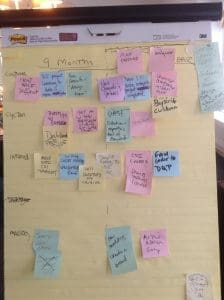
Change is really “Pain”! The human brain just doesn’t want to see things with new eyes or recognize changing times. It actually creates the feeling of pain. So we run away. But the times are changing and we must adapt as well. Our job is to help you do your job and reduce the pain for you, your organization and your business. We developed the ChangeMap process because until you see where you are going and have a plan to get there, the pain just gets worse. You stop trying. Let us tell you more about how we work with you to “see, feel and think” about your challenges in new ways, map your changes and get you on a journey.
Change Mapping!
The main purpose behind business process mapping is to assist organizations in becoming more efficient. There are a number of mapping processes that we have found to be of great value: Story Mapping, Tony Buzan’s Mind Mapping, and Process Mapping are all different ways to organize what people think and do. What they share is the same understanding of the power of the metaphor—the “map,” an extremely useful way to help people see what they are doing and organize how to get there. A clear and detailed business strategy process map or diagram allows us to determine whether or not improvements can be made to the current process.
 As we have worked with companies going through a business strategies change, we’ve experienced a compelling need to add something to these other methods for getting organized. To help us identify the steps in a journey that has to take place at the right time with the right people for the right purposes, we developed a process we called ChangeMapping.
As we have worked with companies going through a business strategies change, we’ve experienced a compelling need to add something to these other methods for getting organized. To help us identify the steps in a journey that has to take place at the right time with the right people for the right purposes, we developed a process we called ChangeMapping.
Our proprietary ChangeMap™ allows our clients to see the entire change process as both a big, even epic, story and small steps along the way. Since the ChangeMap focuses on what has to change, it becomes a real catalyst for thinking and re-thinking what you do today and how you will modify, adapt, discard or redirect it in the future.
How Do We Do A ChangeMap™?
This case was one where they wanted to change their culture. But the process works equally well when you want to open a new market, design a new product or reinvent your business.
We were working with a $250 million company that wanted to become more culturally innovative but was having a difficult time getting started towards changing their business strategy. This could be your culture change challenge as well. Another client knew it had to expand into another area of healthcare to increase its revenue streams but was unclear, and rather anxious, about how to move forward.
This is typical of a change situation, or innovation, or a new business model/business strategy design. We see it all the time. People are stymied not by the ideas but by how to move forward into new territory without getting waylaid by all the obstacles, known and unknown, that will emerge along the way. At times, we think of this as the back-end of innovation. The challenge all too often is how to convert great ideas into impactful new lines of business or ways of getting business done, or in the case of a non-profit, how to expand its mission into new areas.
If this is you, you might begin by hanging flip charts on a wall and breaking out the Post-its. On the far right of one sheet, write down all the details of where you are going to be in three years, as best you can at this time. And get detailed. It is as if you are packing today for a trip that will put you on the road for three years: what is a must-have and what is simply fluff.
Then go backwards with your business strategies, in quarters, or months, if you prefer. By category, list all the things that must be in place if you are going to arrive at your destination ready to go to market. Keep backing up and drawing your map on the flip charts until you have arrived at your starting point, observing the stops and starts along the journey.
We like the metaphor of a map because people get it immediately. It also highlights what has to change at each step of the way. And that is what we focus on. “More of the same” is one thing, but it’s the “change” that we have to push forward with business growth strategies. And that is the part that people avoid.
Give your ChangeMap a try and let us know how it worked for you and your business growth strategy. Or, contact us and we can talk you through it.

